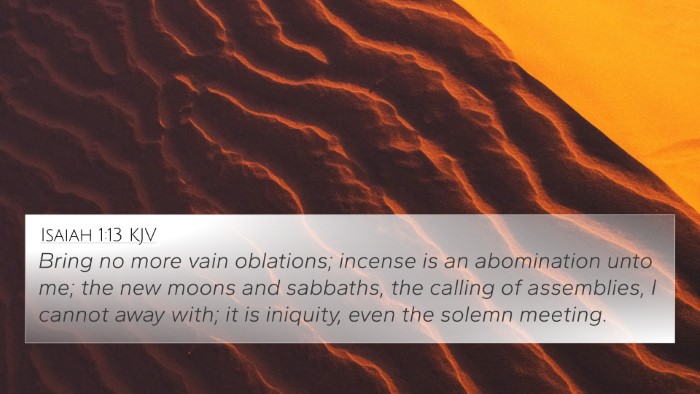Understanding Isaiah 7:10
Isaiah 7:10 states: "Moreover the Lord spake again unto Ahaz, saying..." This verse contains profound implications for faith, leadership, and the nature of God’s communication with humanity. Through an analysis of this verse, we can draw connections to biblical teachings and themes that permeate both the Old and New Testaments.
Contextual Background
The historical context of Isaiah 7 involves the Assyrian threat to Judah during King Ahaz's reign. This moment is crucial as it emphasizes God’s offer of reassurance to Ahaz despite his wavering faith. As we explore the layers of meaning in Isaiah 7:10, we can see how prophetic messages often serve dual purposes—both historical accountability and spiritual instruction.
Insights from Public Domain Commentaries
Matthew Henry’s Commentary
Henry suggests that God's message to Ahaz, occurring after the initial revelations, underscores the importance of seeking divine guidance in times of distress. He emphasizes that God speaks to us continually, urging us not to harden our hearts against His voice. This idea of divine assurance amidst troubling circumstances remains a recurrent theme in scripture.
Albert Barnes’ Notes
Barnes highlights the significance of God’s direct communication. He notes that Ahaz was troubled by the looming threats and needed assurance. In emphasizing God’s willingness to speak, Barnes reinforces the idea that faith must be grounded in reliance upon God's promises, reminiscent of other scriptural assurances found throughout the Bible.
Adam Clarke’s Commentary
Clarke points out that Ahaz's situation illustrates human fear juxtaposed against divine providence. His analysis suggests that this verse reminds believers of the importance of heeding God's voice over political or worldly pressures. Clarke connects this theme to other instances where God reassured His people among daunting challenges.
Thematic Connections with Other Scriptures
Isaiah 7:10 can be connected with various other Bible verses, enriching its interpretation. Below are some cross-references that help deepen understanding:
- Isaiah 7:14 - The prophecy of the virgin birth, further reinforcing God's signs.
- 2 Kings 16:5-7 - The political turmoil during Ahaz’s reign provides context to his state of mind.
- Psalm 46:1 - God as our refuge and strength presents a parallel theme of divine assurance.
- Matthew 1:22-23 - New Testament fulfillment of Old Testament prophecy regarding Immanuel.
- Jeremiah 29:11 - The assurance that God has plans for His people, even in crisis.
- Romans 10:17 - Faith comes by hearing, linking the importance of God’s word in strengthening belief.
- Hebrews 11:1 - Assurance of things hoped for resonates with God’s reassurance to Ahaz.
- Isaiah 41:10 - God’s command not to fear, reinforcing themes of trust in God during fearsome times.
- 1 Peter 5:7 - The exhortation to cast our anxieties on Him, which relates to Ahaz’s challenges.
- James 1:5 - Asking God for wisdom connects with seeking God’s direction as seen in Ahaz’s situation.
Practical Application and Reflection
The verse encourages believers to recognize God's presence in their lives, responding to His call amidst fear and uncertainty. It serves as a reminder that God is not distant but actively involved, urging us to maintain faith in His promises.
Conclusion
In summary, Isaiah 7:10 highlights God’s willingness to guide and reassure His people. The insights from the commentaries, combined with relevant cross-references, create a comprehensive framework for understanding this significant scripture. As we reflect on this verse and its connections, we enhance our spiritual resilience and confidence in God’s unfailing support.
Through the use of tools for Bible cross-referencing, such as Bible concordances and cross-reference Bible study guides, believers can deepen their understanding of the intricate connections between Bible verses. Engaging in cross-referencing Bible study methods enhances one’s ability to identify thematic ties and supports sermon preparation and personal study.
Further Study Recommendations
If you seek to learn how to find and utilize cross-references in the Bible effectively, consider the following:
- Study a Bible concordance to find thematic links between scriptures.
- Use a Bible cross-reference system to explore interconnected ideas.
- Engage in a comparative analysis of Pauline epistles to see theological continuity.
- Explore cross-referenced themes in the Bible for deeper understanding.
- Immerse yourself in the study of links between the Prophets and Apostolic teachings.







